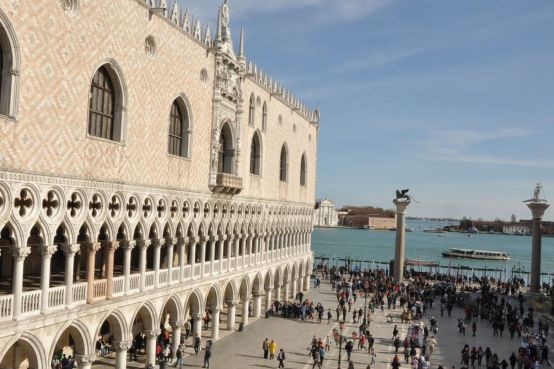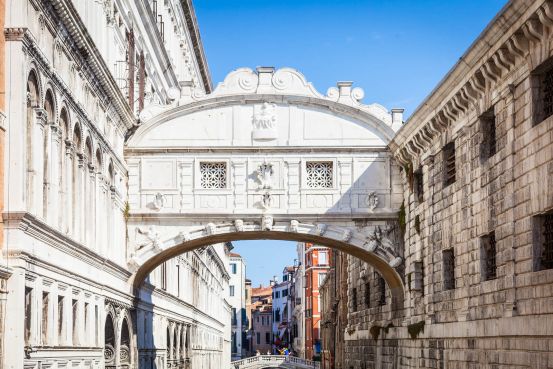The Venetian Republic paid much attention to the symbolic representation of power. Legislative, executive and judiciary functions were in fact only in the hands of the aristocracy whilst physically confined to one place, the Doge's Palace. The Doge's Palace was considered the heart of political and judiciary life. It was the Doge's residence and at the same time the seat of many different political and social institutions.
Enjoy an in-depth Tours of the Doge's Palace that last two-hours covering all the must-see highlights of the Doge's Palace. We also offer Private Tours of the Doge's Palace that include the Secret Itineraries of the Doge's Palace. All tours include skip the line tickets and are led by expert Licensed Venice Tour Guides.
The Doge's Palace was where the senate and the tribune with it's twin prisons operated. New prisons were constructed way beyond the palace so it was decided to construct a bridge to join the Doge's Palace to the new prison structure. Antonio da Ponte was responsible for the work in 1589, but it was completed in 1600 by his pupil Antonio Contino. A covered walkway made from Istrian stone, pre-baroque style.
Very high up from the canal to deter prisoners from escaping. Inside are two separate corridors, one that leads to the first floor court rooms. This was given the nickname ‘dei sospiri' (sighs) so called because of the convicted prisoners who were taken back to the dark and damp cells to serve their sentence. Whilst crossing the bridge they would see the light from the window probably for the last time.
The Doge's Palace has undergone much change over the years after a series of fires before obtaining it's current appearance. A mixture of gothic and renaissance styles. Its facade features two galleries held up by 107 columns (36 below and 71 above).
To enter the palace you must enter the ‘Porta del Frumento' or from the ‘Porta della Carta', the entrance of honour that from Piazza San Marco takes you into the courtyard. This antique entrance, situated between two towers, has been burnt down, rebuilt, demolished and re- built. It has however maintained in it's original place the official entrance between the Doge's Palace and St Mark's basilica.
This gothic masterpiece was designed and built by Giovanni and Bartolomeo Bon between 1438 and 1443. At one time the pinnacles, framework and probably the figures were painted and gilded adding to the richness of the decoration.
Above the door, Doge Foscari kneels before the lion of St Mark's, the symbol of the republic from 828 (the year when the remains of the evangelist Mark where brought back to Venice from Egypt). Work had been initiated by Giovanni who died before work was finished and was completed by his son Bartolomeo Bon, whose name is carved on the beams.
The elegant stairway, the ‘scala dei Giganti', was designed and created by Antonio Rizzo. It's name originates from the two large statues made of Istrian stone built by Sansovino in 1567. The two straight flights of stairs with parapets decorated by small carved columns and slabs of marble both inside and outside. They lead to the internal lodge near the Doge's residence. The passageway between the lodge and the upper landing is made up of three large arches ,with the lion of St Mark's above the central arch.
This was where the Doge was officially invested in front of the aristocracy before the ceremony was consecrated within the basilica and he was presented to the population. Once the Doge's horn was adorned, (the traditional ceremonial headgear), the Doge would walk down the flight of stairs, pass through the Foscari hallway and then he was carried by maritime workers of the arsenal around the square amongst the applauding crowd, who according to an ancient custom would throw money. This was a custom which carried on until the fall of the republic.
Between the Doge's Palace and the palace of justice was a modest flight of wooden stairs connecting the various floors and above all to the senate rooms, created in 1527 by Scarpagnino. However it was not considered up to the standards of the prestigious architecture, so from 1554 it was thought to constructe a stone stairway.
Various projects were suggested by many famous architects, (such as Palladio, Sansovino, Rusconi and Sanmichieli) proving the importance of this route which began with the ‘Porta di Carta' up the ‘Scala dei Giganti' and along the ‘Loggia'. Construction work took place under Doge Andrea Gritti (1523-1538) whose coat of arms appears on the arch of the portal entrance of the Loggia.
The floor ‘delle Logge' is where you will find the rooms where justice was administered, connected to the new prisons by the bridge of sighs. The first floor is the most rich in treasure as there is amongst other rooms the Doge's apartment.
The second floor houses the grand council chamber, the political senate and other rooms where doges were elected and laws voted on. The left hand side of the building is the heart of the prison system with interrogation and torture rooms, and the ‘dei Piombi' upper floor cells where Casanova was imprisoned, while the ‘dei pozzi' cells were in the basement.
The "Maggior Consiglio" - the great council room was one of the most important rooms in the Doges Palace. Within the immense hall (24,68m wide, 52,72m long and 11,40m high) was where the members of the greater council (‘Maggior Consiglio') met to proclaim laws and elect members of the Venetian state.
Originally a popular assembly, however under Doge Pietro Gradenigo (1289-1311) was made up almost entirely by aristocrats. Members of the Venetian bench where around 300 which raised to over 1,600 . All around the side walls and at the front entrance of the wall was an outline drawn by Brustolon from a design by Canaletto. There were nine rows of seats and in the centre of the room two platforms where speakers could intervene.
The Doge would sit next to the entrance in the court. The ‘Sala del Maggior Consiglio' was constructed between 1340 and 1365. After Guariento's fresco of paradise (1365-1368) there was a continued enrichment of mural painting by Gentile da Fabiano, Pisanello, Jacobello del Fiore and Giambono.
This huge art legacy was destroyed during the fire of 20th December 1577. Shortly after restored by Antonio Da Ponte. The new decoration was finished in a short space of time between 1578 and the beginning of the 1600's. I
In 1582, in a very opulent display of wealth the ceiling was carved and gilded as a forerun of the baroque times, as created by Crisoforo Sorte. The pictorial cycle of the ceiling included work by minor artists such as Palma il Giovane, Montemezzano, Vassillacchi, Vicentino, Corona and by Pietro Lungo. 15 vast canvasses recall the victory of Venice as well as other events in it's celebrated history of Venice & the Doges Palace.
The rectangular painting in the centre was carried out just before 1584 by Jacopo Tintoretto and his workshop. It depicts Venice amongst the marine gods who passes the olive branch to Doge Niccolò Da Ponte in the act of paying homage to the senate.
In the oval towards the tribune, Paolo Veronese's ‘Venice crowned by victory between the gods on mount Olympus' is a prestigious example within the Doge's Palace connected with the political success of Venice. It is superbly decorated with silver and pale coloured weave.
The second large oval ceiling towards the window is one of the most significant and rich pieces of work of Palma il Giovane, representing Venice crowned by victory and welcoming the provinces. Tintoretto's work below the ceiling depicts the first 76 Doges from Obelerio Antenoreo (elected in 804) to Francesco Vernier (1554-56). The portrait of Marin Faliero decapitated in 1355 for treason against the state is draped by a black cloth with the inscription recalling the sentence suffered.
The whole of the wall above the tribune is covered by an enormous canvas, the largest in the world, with the ‘paradiso' finished by Jacopo Tintoretto and his helpers in 1590. The huge work substituted the fresco by Guariento which had been ruined by the fire of 1577.
The painting is fascinating for it's dramatic depiction of numerous images of the blessed, saints and prophets, apostles and angels who spin from deep space into the whirlpool obstructed by the shade and light around the two figures of the virgin Mary and Christ.











